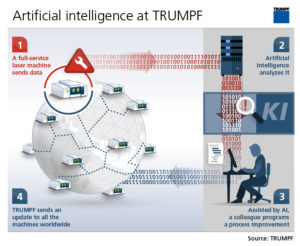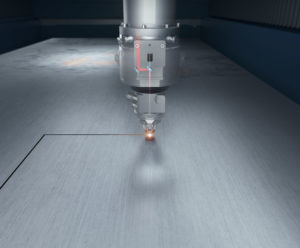Connected production environment gives rise to the smart factory. Heinz-Jürgen Prokop, CEO Machine Tools: “Artificial intelligence is the key to productivity gains”. Smart data analysis helps TRUMPF develop and enhance its machine tools.

TRUMPF showcased numerous solutions for autonomous factories at Euroblech 2018 in Hannover. The company is set to present a range of digitally connected applications for sheet metal processing that are designed to make manufacturing processes simpler and more efficient. “As they become increasingly autonomous, our machines are taking on more tasks and making life easier for the people who work with them. But you can only unlock these benefits with a connected, intelligent production environment. That’s what enables us to achieve productivity gains and secure our customers’ competitive edge – and artificial intelligence is the key,” says Heinz-Jürgen Prokop, Chief Executive Officer Machine Tools at TRUMPF. Prokop notes that there is now little to be gained by striving for ever higher laser power. Instead, the focus should be on connected machines and the processes that occur upstream and downstream from the actual production process. Combined with intelligent data analysis, he argues that this is where the biggest productivity gains can be achieved.
Assistance systems makes processes more reliable

TRUMPF has already laid the foundations for the autonomous factory by including numerous assistance systems in its machines. One example that makes cutting processes more reliable is Smart Collision Prevention. This function’s programming already takes account of tilting parts and then develops a processing strategy in its calculations to avoid collisions with the cutting head. More and more machine functions now control processes autonomously. One example is Smart Nozzle Automation, a function that periodically inspects the nozzle and automatically replaces it if it is damaged. And that’s not the only milestone on the path toward autonomous laser cutting that TRUMPF showcased at this year’s Euroblech in Hannover.
Self-learning machines
The fully automatic TruLaser Center 7030 laser system takes the whole concept of autonomous machines to the next level. From programming to part sorting, everything it does is completely automated. “We’ve already started using intelligent data analysis to improve the processes executed by this machine. By incorporating customer feedback in the form of data, our aim is to steadily perfect the entire system. Artificial intelligence is the next stage of Industry 4.0,” says Thomas Schneider, who heads up machine tool development at TRUMPF. A good example is the machine’s unloading unit. The pins that lift the sheet out of the scrap skeleton are designed to ensure efficient and reliable part removal using suction cups. If the pins fail to get it right the first time around, the machine initiates a new part removal cycle on its own, without requiring any intervention. It then repeats this cycle as many times as necessary until it works. The machine processes and assimilates each of these retry attempts and learns from them.
Smart factory, intelligent logistics
TRUMPF also presented a connected intra-logistics solution at Euroblech, something that TRUMPF has already tested successfully at its Industry 4.0 showcase factory and at selected customer locations. The solution improves the logistics processes that run on the shop floor, for example the routing of parts from one processing station to the next. “Customers participating in our product testing program have sometimes made five-figure savings by deploying our indoor localization system,” says Schneider. “It enables them to reduce search times and prioritize jobs in an intelligent fashion.” This is steadily becoming more important because batch sizes are shrinking and sheet metal fabricators are increasingly struggling to keep track of jobs throughout the entire production process. At the same time, the sheet metal fabricators’ customers want to know what stage their order has reached – a level of transparency they have come to expect from doing business online. The indoor localization system enables TRUMPF customers to manage their production processes more efficiently and satisfy their own customers’ expectations.
Major gains in productivity with Active Speed Control

This year’s Euroblech sees TRUMPF present a major milestone on the road toward autonomous machines: Active Speed Control. With this new feature, the system looks straight through the nozzle right at the cutting zone, monitoring it in real-time and autonomously controlling the feed rate of solid-state laser machines. This new function ensures a more reliable process for both flame and fusion cutting, reducing scrap and saving on rework. Active Speed Control also responds immediately to any changes in the material being processed. The system allows users to achieve tangible gains in productivity with their machines, significantly lowering part manufacturing costs. Active Speed Control monitors numerous different process parameters. One example is the position of the laser beam in relation to the center of the nozzle during the entire cutting process. The system informs the operator of any deviations, helping to avoid scrap. Additional functions for automated laser cutting can easily be added to the system in the future thanks to the software update feature. TRUMPF is well ahead of the curve when it comes to investing in digitally connected, autonomous factories, and this year’s Euroblech sees the high-tech company showcasing numerous other innovations for the smart factory in addition to Active Speed Control.
Maximum speed even with variations in material thicknesses
The kerf reveals all sorts of information about part quality and process stability. The easier it is for the molten material to escape from the kerf, the smoother the cutting process. Active Speed Control keeps a careful eye on this flow of molten material in mild and stainless steel plates that are four or more millimeters thick. The sensor system looks straight through the nozzle to observe the radiation that is emitted as the material melts. This “process radiation” allows the system to determine whether the molten material is emerging as planned, to identify the fastest possible feed rate, and to make any necessary adjustments – a process it repeats many hundreds of times a second. In this way, Active Speed Control maintains the optimum feed rate even in cases where the thickness of the material varies within a single sheet, or where the top of the sheet is contaminated with rust or paint. In conventional systems, these kinds of variations and changes in material would typically lead to slag formation or interruptions in the cutting process.
Smart sensor system makes life easier for machine operators
Currently, machine operators have to tailor the feed rate – a critical parameter – to the material they are cutting, and adjust it as necessary. One way they do this is by making test cuts. Active Speed Control eliminates the need for these kinds of tests. That simplifies the production process, particularly in single part manufacturing. To allow for variations in the material, operators also frequently reduce the machine’s feed rate. That makes the process more reliable in many cases, but it often has a negative impact on the cutting process and the quality of the cut. For example, a lower feed rate can cause heat to accumulate within the material. This build-up of heat can cause the material to melt in an uncontrolled fashion, reducing the reliability of the machining process. By automatically controlling the feed rate, Active Speed Control prevents this accumulation of heat from developing in the first place. This feature also offers plenty of other benefits. For example, the operator can view a live image of the cutting zone as seen through the nozzle, and they can browse key process parameters at any time on the machine’s control panel or on a tablet. That makes it easier to monitor the machine during production. Previously, operators had to manually create what is known in the industry as a “tapeshot” to ensure that the parameters were set to their optimum values – and that was a laborious and time-consuming process.
Speeds well above the norm
Cutting data tells the machine how to process material of a certain thickness. The calculation of this data includes a buffer to compensate for any variations in the composition of the sheet and to allow for less experienced operators who may not have configured the machine optimally for the next job. Ultimately, this means the machine is cutting at a lower feed rate than it is capable of. Active Speed Control eliminates the need for this buffer. The sensor system allows the machine to always work as fast as it can while maintaining the required levels of process reliability. In many cases, Active Speed Control even achieves speeds that are significantly higher than the default values specified in the cutting data.
Improving part quality while reducing part costs
Parts that have not been completely cut from the skeleton or that feature a lot of slag lead to higher scrap rates and wasted time – especially if the cutting problems occur during a night shift. But with automatic feed control, this hardly ever happens. In the event of a miscut, Active Speed Control brings the machine to a halt, and the TruTops Monitor software immediately notifies the operator that they need to take action. Active Speed Control also reduces burr and slag formation.
Innovation for autonomous laser cutting
TRUMPF 2D laser cutting machines feature numerous different assistance systems that help operators cut parts in a reliable fashion. One example is Smart Collision Prevention, which is programmed to take tilting parts into account and then develops a processing strategy in its calculations to avoid collisions with the cutting head. Meanwhile, the Drop&Cut assistance system makes it easier than ever to produce additional parts from scrap skeletons. As well as providing assistance, TRUMPF machines also feature an increasing proportion of functions that control processes autonomously. One example is Smart Nozzle Automation, a function that periodically inspects the nozzle and automatically replaces it if it is damaged. The TruLaser Center 7030 runs all its processes in a completely automated fashion, from programming to part sorting. Active Speed Control is yet another example of TRUMPF’s ongoing mission to create innovations on the path toward autonomous laser cutting.



